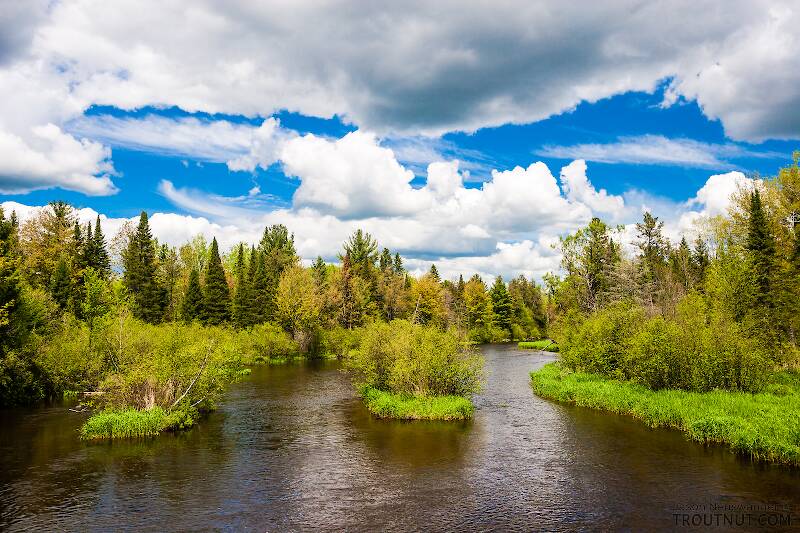
Salmonflies
Pteronarcys californica
The giant Salmonflies of the Western mountains are legendary for their proclivity to elicit consistent dry-fly action and ferocious strikes.


Mayfly Species Isonychia arida (Slate Drakes)
Species Range
Physical description
Most physical descriptions on Troutnut are direct or slightly edited quotes from the original scientific sources describing or updating the species, although there may be errors in copying them to this website. Such descriptions aren't always definitive, because species often turn out to be more variable than the original describers observed. In some cases, only a single specimen was described! However, they are useful starting points.
Male Spinner
Wing length: 8-12 mm
A species having pale yellowish areas in the antero-lateral angles of each abdominal segment, and pale venation.
Head light reddish to brownish. Thorax dark reddish brown, very shiny; pleura a paler shade of the same color, sternum somewhat darker. Fore leg of male about as long as the body. Femur dark reddish brown, paler at the base; tibia and tarsus brown, darker at the joinings. Tibia may be paler in the middle, dark at either end; basal halves of the tarsal joints may be paler. Middle and hind legs yellow, tips of the tarsi a little darker. Wings hyaline, veins pale; in female, may be very faintly brownish.
Abdomen deep reddish brown, little if any paler ventrally. Each tergite and each sternite marked with yellow areas in the antero-lateral angles; in addition, another yellow patch is present on the anterior margin of each tergite, nearer the median line. There is no pale mid-dorsal stripe. Tergite 10 is deep bright orange. Tails yellowish white, unmarked. Forceps light yellowish brown. Forceps base very slightly excavated apically. Penes separated by a shallow rounded notch; the outer angles acute. Below these is a toothed flap or projection, folded back onto the body of the penes (see fig. 124).
Described as I. pictipes
Body length 8-9 mm, wing length 8-10 mm
A small pale species, with bicolored fore tibia and pale venation. Head pale reddish. Frontal margin narrowly black. A black spot between the eye and the antenna. Head of female flesh-colored; no reddish median stripe; a faint reddish line follows the inner margin of the eye. A large black spot in the corner of the occiput, and a smaller dark dot nearer the median line. Thorax reddish tinged with yellow, which is most evident on the lateral portion of the anterior half of the mesonotum and the sides of the metanotum. Scutella and sternum darker reddish brown. Fore femur madder red, paler at base, margined with black apically. Tibia bicolored; pale yellowish in the center, the basal third and a narrower band at the apex dark reddish brown. Tarsus pale smoky brown; the basal half of the first and second joints, and the basal third of the third joint, pale. Fore tarsus slightly longer than tibia. Middle and hind legs whitish tinged with amber; claws dusky. Wings hyaline, venation wholly pale.
Abdomen pale reddish, paler ventrally. Basal segments darker, apical segments brighter red. Prominent purplish black bands on the posterior margins. Stigma marked by a short black line. A dusky streak closely parallels the pleural fold on each tergite. An obscure paler mid-dorsal line may be present. Tails pale yellowish white, wholly pale at tip. Joinings pale. Extreme basal joints may be faintly flushed with pinkish. Genitalia yellow, often tinged with red. Forceps base deeply excavated apically; its lateral arms rather wide. Penes very similar to Isonychia sicca. Subanal plate of female deeply excavated apically, its outer angles acute. This plate and the lateral extension of the 9th segment translucent.
The strikingly marked fore tibia should readily distinguish this species from sicca, manca (now a synonym of I. sicca), and Isonychia campestris, which species it resembles in type of genitalia.
Female Spinner
In female, bright yellow, the corners of the occiput blackish, and a black line between the eye and the lateral ocellus. A yellow lateral line extends across the pleura from the wing roots. Wings hyaline, veins pale; in female, may be very faintly brownish. Penes separated by a shallow rounded notch; the outer angles acute. Below these is a toothed flap or projection, folded back onto the body of the penes (see fig. 124). Subanal plate of female likewise but slightly excavated on its apical margin, its outer angles rounded.
Start a Discussion of Isonychia arida
References
- Jacobus, L. M., Wiersema, N.A., and Webb, J.M. 2014. Identification of Far Northern and Western North American Mayfly Larvae (Insecta: Ephemeroptera), North of Mexico; Version 2. Joint Aquatic Science meeting, Portland, OR. Unpublished workshop manual. 1-176.
- Merritt R.W., Cummins, K.W., and Berg, M.B. 2019. An Introduction to the Aquatic Insects of North America (Fifth Edition). Kendall/Hunt Publishing Company.
- Needham, James G., Jay R. Traver, and Yin-Chi Hsu. 1935. The Biology of Mayflies. Comstock Publishing Company, Inc.
Mayfly Species Isonychia arida (Slate Drakes)
Species Range
Common Names
Resources
- NatureServe
- Integrated Taxonomic Information System
- Global Biodiversity Information Facility
- Described by Say (1839)

